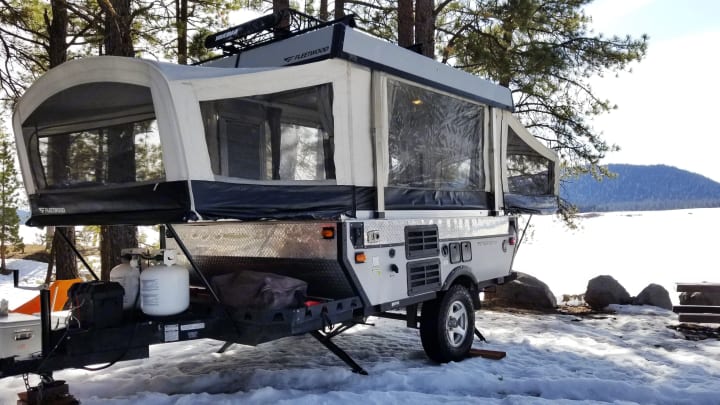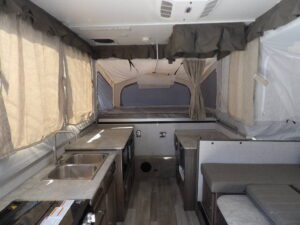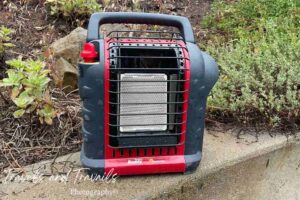Many of us follow the rules of “camping season,” which say that unless you live in Florida or an equally warm climate, your RV better be in a heated storage facility until March or April. We certainly don’t think of bringing a pop-up camper for our winter adventures, but why not?
Are pop-ups the worst choice for winter camping, or can they withstand the chill? Pop-ups can survive winter camping if you prepare accordingly by insulating, patching up any seams and gaps, using a composting toilet, and augmenting indoor heating through a propane or electric heater.
This guide will take you through the ins and outs of camping in a pop-up over the winter so you can decide if you’re ready to brave the wilderness!
How Well Do Pop-Up Campers Do in Winter?
When considering camping in the winter, you want optimal cold protection. A pop-up seems like the antithesis of that, as its thin tent walls would shake and rustle with every breeze, letting cold air in between the gaps and leaving you shaking to the bone.
However, it doesn’t have to be like that!
Pop-up campers are not an averse solution for wintertime motorhome adventures. They’re not ready for the cold by default, but with the right measures, you can enjoy a weekend in the wilderness in the middle of January in your pop-up.
Preparing your camper for winter adventures is not necessarily the same as winterizing it. Winterizing involves draining all the fluids and emptying all the tanks so they don’t freeze.
When you camp in your pop-up, you probably still want to use your tanks, so you don’t have to drain everything.

Preparing Your Pop-Up Camper for Winter: All You Need to Know
So, what is required to make a pop-up winter-ready? Let’s review the steps and processes.
Insulating
The first task on your list is the biggest difference-maker regarding how comfortable you’ll feel.
Insulating your pop-up camper adds a thermal layer of protection from the cold. You’ll also enjoy more peace and quiet, as insulation can provide some soundproofing. It won’t be quiet enough to hear a pin drop, but outdoor noise volume will be noticeably reduced.
As a bonus, insulation also traps cool air in the summer, so your pop-up will be more energy-efficient all year.
Blocking all the openings across your pop-up, which I’ll discuss shortly, is one part of insulation.
Here are some other insulation tasks you should add to your list.
- Upgrade the underskirting: The skirt around your pop-up prevents the components under your camper from freezing in the winter. If the skirt is in tatters or otherwise in poor shape, do yourself a favor and upgrade.
- Sealing the doors and windows: Your pop-up must have airtight doors and windows, which is innately difficult considering the type of camper you drive. Plastic insulating film is a pop-up-friendly solution. You can also consider using a door snake, placing reflecting insulation sheets on the windows (which block sunlight), caulking around the doors and windows, replacing the weatherstripping, or buying new doors and windows.
- Blocking the skylights: Foam board works to block the skylights. You can also cover the vents in tandem, but make sure to take the vent cushions off when you open the vents.
You can also insulate the walls. Spray foam insulation can work for the soft tent walls of your pop-up, while any hard walls are good candidates for rigid foam and fiberglass insulation.
Let’s explain how each works.
Spray foam insulation comes out of a spray canister. It’s foolproof, easy to install, and inexpensive. However, its R-value isn’t as high as the other two types of RV insulation.
An R-value is how well the insulation can repel conductive heat flow. The higher the R-value, the more efficient the insulation.
Rigid foam insulation is available as boards or panels you affix to your walls. That’s why it’s inappropriate for soft pop-up camper walls. This type of insulation lasts longer than spray foam but doesn’t have as much moisture resistance.
The R-value of rigid foam insulation is higher, and its lifespan is impressively long. It’s more difficult to install, as you must cut it down to size and adhere it with industrial tape or caulk.
The third type of insulation to consider for your camper is fiberglass. This is the most common choice of the three, what with its high R-value and affordability. Fiberglass insulation also installs easier than rigid foam insulation but not as easily as spray foam.
Further, it doesn’t last as long, and it has the least amount of moisture resistance, so mold and mildew could develop.

Patching Up Gaps and Seams
The next task on your to-do list is to close any openings, seams, and gaps.
You already tackled the windows and doors, which is a good start. Next, move on to the roof. First, check for loose threads, tiny holes, or burst seams in the pop-up canvas. Consider throwing an insulating tarp over the roof, as that’s the best way to insulate this space.
You’ll feel warmer in your camper and enjoy greater protection from the elements. The tarp might help your camper last longer, especially considering the roof has the most exposure to the elements.
Next, go through all the beds in your camper and insulate underneath them. This might seem like an odd choice, but any bed that pops out can introduce cold air into the camper. You’ll also struggle to sleep, as you’ll be freezing cold.
Use silicone sealant or foam insulation boards under the bed to block the cold air.
Have you checked the edges and seams for tears, leaks, holes, and other damage? Even small holes can let air in, especially if you have enough.
Using a Composting Toilet
Here’s the thing about pipes and cold weather. They risk freezing even if you don’t winterize your pipes (you know, because you’re still using them). Water getting stuck in a pipe can crack it, and long-term cold exposure can make the pipes brittle enough to burst.
When the water thaws, it could put pressure on brittle pipes, leading to a leak.
Water damage is just as detrimental in a pop-up camper as in any other camper style or motorhome. You could incur thousands to tens of thousands of dollars in repairs, or your camper could be so far past gone that you have no choice but to replace it.
That’s why you might want to consider another plumbing system for your wintertime camper adventures, such as a composting toilet.
These toilets are quite unlike the ones you have at home. They don’t use any water, so they don’t require plumbing. Instead, the waste breaks down naturally and organically.
If you’ve ever created a compost pile for a home garden, the concept is the same. As I’m sure I don’t have to tell you, a composting toilet doesn’t smell like a bed of roses. It’s literally the opposite.
However, it’s a much more eco-friendly bathroom choice than a standard toilet, and it will preserve your camper, as you won’t have any plumbing pipes to stress over.
Here’s more information about composting toilets and other cold-weather alternative toilets.
Creating Sufficient Warmth with a Portable Heater

Warmth is a huge factor when camping in the winter. Insulating your pop-up isn’t enough to keep you warm. You must also introduce additional heat sources, such as a portable heater.
A portable heater can supplement the furnace your camper might already have. If you bought a pop-up without a heat source, you cannot go without a portable heater when camping this winter.
Electric and propane are the two most common selections for RV and camper owners who stay out long past the standard season.
I just discussed the merits of propane and electric heaters in another blog post, so this section will largely act as a recap.
Electric heaters come in many shapes, sizes, and styles to suit bigger and smaller pop-up campers. They have built-in safety features and can provide concentrated warmth in one area.
The electricity supply to your heater is infinite, provided your camper is plugged into shore power. If you’re considering boondocking this winter or will camp anywhere you expect an interrupted power supply, an electric heater isn’t viable.
Electric heaters don’t provide whole-camper warmth. They can generate heat for the area closest to where they’re plugged in. You might need several electric heaters, depending on the layout of your camper.
One of the biggest advantages of an electric heater is the reduced cost. You only spend on the heater and any electricity you must pay for at a campsite.
Your other option is a portable propane heater. These heaters provide warmth in a more encompassing fashion than an electric heater, so you might be able to use fewer and stay warm.
Propane heaters also have safety features, a must, considering they can release deadly fumes into the air. You must still have a carbon monoxide detector in your pop-up.
You can also safely go boondocking with a propane heater since it doesn’t require a power source.
The only downsides are the risk of carbon monoxide poisoning (again, please get a carbon monoxide detector) and the fact that you must buy and store propane continually to keep this heater operating.
Another heating option for your pop-up camper is a diesel heater. Here is an article that I wrote about what to look for when buying a diesel heater.
The Pros of Camping in a Pop-Up in the Winter
Wintertime camping in a pop-up isn’t for the faint of heart. However, if you can grin and bear it, you can expect enormous rewards for your time and cold tolerance.
Good for Your Health

Winter is a time when we become sedentary. The cold temperatures and sparse daylight leave us feeling languid until the spring. This dark period is also when many people’s moods can take a dip due to the reduced daylight.
Spending time in nature during the winter benefits your physical and mental health like any other time of the year. You’ll shake off your physical doldrums as you get active and spend your days hiking, fishing, and exploring.
You’ll also feel good mentally. You might not have as much daylight to work with, but you’ll make the most of the hours you’ve got, reaping the benefits of vitamin D. The exercise will also produce endorphins, feel-good chemicals to improve your mood.
Less Sweating
Who likes sweating? I know I don’t, and I bet many of you reading this share the same sentiment. Sweating is necessary but gross.
You’re less likely to sweat when hiking or climbing in the winter than exerting yourself as much in the spring or summer. That’s not to say sweating is impossible in the winter (it definitely isn’t), but you won’t be bathed in it by the end of the day unless you push yourself to the max.
Different Wildlife
The warmer months will always be better for flora and fauna, but the wildlife variety is a different experience when camping in the winter versus the summer. Creatures like red foxes, deer, snowshoe hares, beavers, and chickadees are more common sights in the cold months.
You can appreciate a new side of Mother Nature when you take your pop-up camper out in the winter.
Low-Cost Park Entry
Budgeters, rejoice. You can shave off the cost of your entry fee into that state park or national forest by camping in the winter. This is the non-busy season, so parks won’t usually charge you full admission.
That said, some parks shut down entirely over the winter, so always research where you want to go so you don’t waste time and gas.
Fewer Crowds
You’ll never completely avoid the crowds unless you truly camp in the middle of nowhere, but you’ll see far fewer people when you camp in January or February than in April or May. Enjoy the peace, tranquility, and space of the experience, as it’s not something you get to savor all that often.
(Almost) Bug-Free
The outdoors is a bug’s domain, and while many species go dormant in the winter, not all. However, you won’t be slapping mosquitos off your skin or swatting away bees, so there is some upside.
The Cons of Camping in a Pop-Up in the Winter
As awesome as camping in your pop-up over the winter can be, you can’t completely ignore the downsides. Here are some to be aware of.
It’s Cold!
The feeling of coldness can become like the pink elephant. The more you try not to think about it, the harder it is not to. When all you think about is how cold you are, you can easily become miserable.
The only time you’ll get relief is when you’re in your pop-up camper with the electric or propane heater running, and that’s not very fun.
Layering can help you stave off the cold feeling. Fun fact: layering in the summer will also keep you comfortable, so it’s a skill worth mastering.
Less Daylight
The reduced daylight hours are a bummer in several ways. You can’t pack as many activities into your itinerary because you have less time to work with. The longer hours spent in the dark can get especially chilly and boring, especially if you’re boondocking or otherwise camping without power.
Frostbite and Hypothermia Risks
You must always be careful when taking expeditions into the wilderness during the winter. Inadequate insulation and heating increases your risk of hypothermia and frostbite, both of which can be deadly.
Bottom Line
Cold-weather camping in a pop-up camper is a possibility. With a bit of insulation and a portable heater, you can prepare your pop-up to brave the coldest days winter can throw at you. You’ll enjoy smaller crowds and fewer bugs for your troubles!
